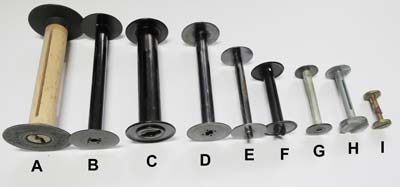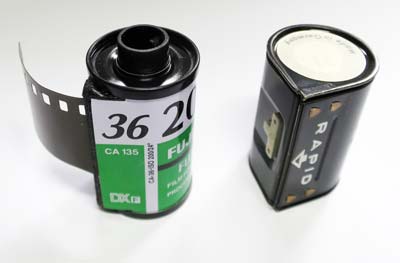Film Formats for Art Deco Cameras
Camera Formats
Classification
Cameras are classed depending on the size of the image on the film.
- Large: 102mm x 127mm and larger (4" x 5")
- Medium: 40mm x 40mm and larger (1⅝ x 1⅝)
- Miniature: 24mm x 24mm and larger (1" x 1")
- Subminiature: Less than 24mm x 24mm (1" x 1")
There have been many attempts to classify cameras over the years so you may find cameras classified differently. For example, 35mm was classed as 'miniature' when it first appeared, but now is often called 'small'.
Common Film Formats
Daylight Loading Spools
Most daylight loading spools have a backing paper which is wound on a spool with flanges at each end. One end of the the spool has a slot that matched a key in the camera to enable the film to be advanced. Most early spools had a thick wooden core and metal flanges, later the whole spool was made of metal and lastly plastic. The film was wound so that it was inside the backing paper, which which formed a light tight seal.
828 Film
This is roll-film wound on a narrow metal core. The film is 35 mm wide and, on early examples, had one hole per frame on one side of the film. This hole caused the advance mechanism to stop when the next frame was in position.
35mm Cassettes
Cassettes introduced by Agfa in 1932 and Kodak in 1934 became the standard pattern for disposable 35 mm cassettes.
The film is 35 mm wide with perforations along each edge. The standard frame size was 24 x 36 mm but sometimes 24 x 18 mm was used and became known as half-frame.
Agfa Karat/Rapid
The Karat cassette, introduced in 1936, used standard 35 mm film but for only 12 exposures. The film was held loose in separate feed and take-up cassettes and was advanced by the sprocket holes. The film moved from one cassette to the other and was not rewound.
Spools
Common Spool Sizes

| Letter | Type | Used in this Camera |
|---|---|---|
| A | 116 | Kodak No 2A Beau Brownie |
| B | 616 | Kodak Six-16 Brownie |
| C | 120 | Ensign Pocket Twenty |
| D | 620 | Fex/Indo Ultra Himalaya |
| E | 127 | Jiffy "Kodak" V.P. |
| F | 828 | Kodak Bantam Special |
| G | E10 | Ensign Midget |
| H | Univex #00 | Univex AF-2 |
| I | 16mm | Coronet Midget |
35mm and Rapid cassettes

Common film sizes for Art Deco Cameras
Some common film sizes used in the Art Deco period. All sizes approximate.
Kodak
| Film Number | Number of Exposures | Frame Size Inches | Frame Size cm (approx.) |
|---|---|---|---|
| 116 | 8 | 2½ x 4¼ | 6.5 x 11 |
| 116 | 12 | 2½ x 2½ | 6.5 x 6.5 |
| 116 | 16 | 2½ x 2⅛ | 6.5 x 5.5 |
| 616 | 8 | 2½ x 4¼ | 6.5 x 11 |
| 616 | 12 | 2½ x 2½ | 6.5 x 6.5 |
| 616 | 16 | 2½ x 2⅛ | 6.5 x 5.5 |
| 120 | 8 | 2¼ x 3¼ | 6 x 9 |
| 120 | 12 | 2¼ x 2¼ | 6 x 6 |
| 120 | 16 | 2¼ x 1⅝ | 6 x 4.5 |
| 620 | 8 | 2¼ x 3¼ | 6 x 9 |
| 620 | 12 | 2¼ x 2¼ | 6 x 6 |
| 620 | 16 | 2¼ x 1⅝ | 6 x 4.5 |
| 127 | 8 | 1⅝ x 2½ | 4 x 6 |
| 127 | 12 | 1⅝ x 1⅝ | 4 x 4 |
| 127 | 16 | 1⅝ x 1¼ | 4 x 3 |
| 828 | 8 | 2.8 x 4 | |
| 135 | 24/36 | 2.4 x 3.6 |
Ensign/Coronet
| Film Number | Number of Exposures | Frame Size Inches | Frame Size cm |
|---|---|---|---|
| E10/EC10/M10 | 6 | 1¼ x 1⅝ | 3.1 x 4.1 |
UniveX
| Film Number | Number of Exposures | Frame Size Inches | Frame Size cm |
|---|---|---|---|
| #00 | 6 | 1⅛ x 1½ in; | 2.8 x 3.8 |
Film Equivalents
| Kodak | Ensign | Ilford | Agfa | Zeiss |
|---|---|---|---|---|
| 116 | E16 | 16 | D | D8 |
| 120 | E20 | 20 | B2 | B11/8 |
| 127 | E27 | 27 | A | A8 |
| 616 | Z.16 | PD | DM8 | |
| 620 | E62 | Z.20 | PB | B11/M8 |
| 828 | 88 | |||
| E10 | 10 |
Obtaining Film
120 120 roll film is easily available from a number of outlets.
620 620 film is still available in the UK from selected outlets on the web. ( e.g. snapsphotoservices.com). 620 film is basically 120 film re-rolled on to smaller spools so you could re-roll it yourself in a darkroom or a changing bag. Don't try to use 120 film because it will jam. When you take in your film for developing, don't forget to ask for the 620 spool back as a spare.
127 127 film is still available from select outlets - search for 'Rera Pan 100-127'. In the UK, get it from Nik & Trick Photo Services. If you want to use a particular type of film which is not available commercially, then you can cut your own 127 film from any 120 film. See my page on 'How to cut 127 film from 120 film'.
828 Very difficult to find. My advice is to buy an expired film and try it. I have used a film expired in Sept 1966 and got some acceptable images from it. However, when you have it developed, make sure you get the backing paper and spool back because it can be reloaded with 35mm film in a darkroom or a changing bag. There are then several hacks to get images from it but it can be done. Good Luck.
Agfa Rapid Agfa Rapid cassettes basically use 35mm film. However, it will need to loaded in a darkroom or changing bag. Again several more hacks required to get images. Check out my page on loading 35mm film into Karat cassettes.
116 Your camera will need to be modified to take 120 film. These modifications are usually reversible so don't worry about damaging your camera. There are two main options - either convert to a panoramic image or convert to a smaller image with more frames. For methods see:- Converting a 116 camera to 120.
616 Your camera will need to be modified to take 120 film. These modifications are usually reversible so don't worry about damaging your camera. There are two main options - either convert to a panoramic image or convert to a smaller image with more frames. For methods see:- Converting a 616 camera to 120.